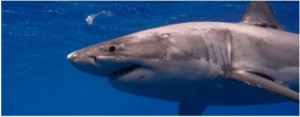04/18/13 – Joint news release – UH SOEST and Hawai‘i DAR researchers provide new understanding of rare white shark movement around Hawai‘i
Posted on Apr 18, 2013 in News ReleasesDEPARTMENT OF LAND AND NATURAL RESOURCES
News Release
| NEIL ABERCROMBIE GOVERNOR |
WILLIAM J. AILA JR,
CHAIRPERSON |
For Immediate Release April 18, 2013
Joint news release
UH SOEST and Hawai‘i DAR researchers provide new understanding of rare white shark movement around Hawai‘i

White shark in water near Guadalupe, Mexico, which is one of the source areas for sharks that visit Hawai‘i.
Photo credit: Kevin Weng, UHM.
Honolulu, HI – A study just published in the Journal of Marine Biology sheds new light on the relatively rare but occasionally recorded presence of white sharks in waters surrounding the Hawaiian Islands, and suggests a new method to help distinguish between white sharks and close relatives, such as mako sharks. The paper, titled “Occurrence of White Sharks in Hawaiian Waters”, was written by Kevin Weng of the University of Hawai‘i – Manoa’s School of Ocean and Earth Science and Technology (SOEST) and Randy Honebrink of the Hawai‘i DLNR Division of Aquatic Resources (DAR).
Honolulu, HI – A study just published in the Journal of Marine Biology sheds new light on the relatively rare but occasionally recorded presence of white sharks in waters surrounding the Hawaiian Islands, and suggests a new method to help distinguish between white sharks and close relatives, such as mako sharks. The paper, titled “Occurrence of White Sharks in Hawaiian Waters”, was written by Kevin Weng of the University of Hawai‘i – Manoa’s School of Ocean and Earth Science and Technology (SOEST) and Randy Honebrink of the Hawai‘i DLNR Division of Aquatic Resources (DAR).
According to William Aila, chairperson of the State of Hawai‘i Department of Land and Natural Resources, “This study is valuable in that it provides a better understanding of the biology and behavior of white sharks, which is very useful for management purposes. White sharks were caught by pre-contact Hawaiians, and their teeth used in weapons and other implements. But in many ways they continue to mystify us today.”
Satellite tracking studies have previously shown that Hawai‘i’s white sharks are migrants from population centers off California and Mexico. A relatively small proportion of those West Coast sharks migrate all the way to Hawai‘i, which is why they are so rarely seen.
The authors reviewed all available sources of information relating to white sharks in Hawai‘i, including newspaper accounts of shark attacks, shark control program catch records, photos and videos from various sources, and satellite tracking data. Only data that could be confirmed as pertaining to white sharks was included in the analysis. In cases where information was insufficient for positive species identification, the sightings were eliminated.
According to Dr. Weng, “We learned that white sharks occur in Hawai‘i across a broader part of the annual cycle than previously thought – we recorded observations from every month except November. This is important for our understanding of white shark life history and population.”
Since all records of white sharks in Hawaiian waters are of individuals larger than 3.3 meters (10.8 feet), and no juveniles have ever been reported, there is no evidence of white sharks being residents or pupping here.
Scientists have learned a great deal about the migratory patterns of white sharks in the Eastern Pacific since the advent of satellite tracking, but important questions remain. “Our satellite tracking studies have been conducted in places where we can get very close to the animals – seal colonies – but this means that we may be sampling a subset of the population, and thus obtaining biased results,” said Weng. “It is possible that there are individuals that do not aggregate around seal colonies.”
“Male and female white sharks have different migration patterns,” explained Weng. “Males have been recorded in Hawai‘i from December through June, but females have been observed here all year round.” Female white shark visits to Hawai‘i may be related to a two-year reproductive cycle, in which they return to coastal aggregation sites off California and Mexico on alternating years. That leaves them with more time to spend in Hawai‘i, where warmer water temperatures may speed up fetal development. Our results are consistent with a very recent paper by Domeier and Nasby-Lucas in the journal “Animal Biotelemetry.”
Misidentification of similar looking sharks, such as makos, has been a recurring problem. A recent example was the sighting of a shortfin mako shark off Ka‘ena Point, O‘ahu, on Jan. 12, 2012. This sighting, captured on a video that “went viral,” was reported around the world as a white shark by the news media, an error that continues to this day.
This study proposes a simple method to help distinguish between the two species based on the shape of the head. Mako sharks have a more acute head shape than white sharks. Since many sightings only obtain photographs of the head, this method should be helpful for situations with limited information and no specimen.
# # #
Dr. Kevin Weng will be available for interviews today, April 18, from 10 am – 12 pm on UHM campus. Please call to arrange a meeting.
K Weng and R Honebrink, Journal of Marine Biology Volume 2013 (2013), Article ID 598745, https://dx.doi.org/10.1155/2013/598745. Supplementary Material available here: https://www.hindawi.com/journals/jmb/2013/598745/sup/
Copyright © 2013 Kevin Weng and Randy Honebrink. This is an open access article distributed under the Creative Commons Attribution License, which permits unrestricted use, distribution, and reproduction in any medium, provided the original work is properly cited.
More information on this research can be found here: https://www.soest.hawaii.edu/oceanography/faculty/kweng/kweng_lab/Hawaii_white_sharks.html
The School of Ocean and Earth Science and Technology at the University of Hawaii at Manoa was established by the Board of Regents of the University of Hawai‘i in 1988 in recognition of the need to realign and further strengthen the excellent education and research resources available within the University. SOEST brings together four academic departments, three research institutes, several federal cooperative programs, and support facilities of the highest quality in the nation to meet challenges in the ocean, earth and planetary sciences and technologies.
www.soest.hawaii.edu
